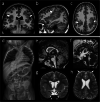Symptomatic eating epilepsy: two novel pediatric patients and review of literature
- PMID: 34118959
- PMCID: PMC8199818
- DOI: 10.1186/s13052-021-01051-2
Symptomatic eating epilepsy: two novel pediatric patients and review of literature
Abstract
Eating epilepsy (EE) is a form of reflex epilepsy in which seizures are triggered by eating. It is a rare condition but a high prevalence has been reported in Sri Lanka. In EE, the ictal semiology includes focal seizures with or without secondary generalization or generalized seizures. Some cases are idiopathic while focal structural changes on imaging, if present, are often confined to the temporal lobe or perisylvian region. On the other hand, some cases support the hypothesis of a genetic aetiology. The prognosis of EE is extremely variable due to the different nature of the underlying disorder. We describe two patients with symptomatic eating epilepsy, a 13-year-old boy with a bilateral perisylvian polymicrogyria and a 2-year-old boy with a genetic cause. The presence of structural lesions or the dysfunction of specific cortical regions in the context of a germline genetic alteration might lead to a hyperexcitation fostering the epileptogenesis. We review the available literature to clarify the aetiopathogenesis and the mechanisms underlying EE to improve the diagnosis and the management of these rare conditions.
Keywords: Eating epilepsy; Reflex seizures; Symptomatic epilepsy.
Conflict of interest statement
The authors declare that they have no competing interests.
Figures


Similar articles
-
Eating epilepsy is associated with initial precipitating events and therapy resistance.Clin EEG Neurosci. 2013 Apr;44(2):161-6. doi: 10.1177/1550059412459509. Epub 2013 Feb 6. Clin EEG Neurosci. 2013. PMID: 23389623
-
Bilateral perisylvian ulegyria: an under-recognized, surgically remediable epileptic syndrome.Epilepsia. 2013 Aug;54(8):1360-7. doi: 10.1111/epi.12160. Epub 2013 Apr 15. Epilepsia. 2013. PMID: 23586600
-
Chewing induced reflex seizures ("eating epilepsy") and eye closure sensitivity as a common feature in pediatric patients with SYNGAP1 mutations: Review of literature and report of 8 cases.Seizure. 2019 Feb;65:131-137. doi: 10.1016/j.seizure.2018.12.020. Epub 2018 Dec 22. Seizure. 2019. PMID: 30685520 Review.
-
Unilateral opercular lesion and eating-induced seizures.Epileptic Disord. 2010 Dec;12(4):309-13. doi: 10.1684/epd.2010.0347. Epub 2010 Nov 29. Epileptic Disord. 2010. PMID: 21112825
-
Ictal Video-Electroencephalography Findings in Bathing Seizures: Two New Cases and Review of the Literature.Pediatr Neurol. 2019 Oct;99:76-81. doi: 10.1016/j.pediatrneurol.2019.04.017. Epub 2019 Apr 26. Pediatr Neurol. 2019. PMID: 31272783 Review.
Cited by
-
Eating Epilepsy in an Acute Lymphocytic Leukemia Survivor.Indian J Pediatr. 2024 Aug;91(8):875. doi: 10.1007/s12098-024-05113-1. Epub 2024 Apr 3. Indian J Pediatr. 2024. PMID: 38565764 No abstract available.
-
Seizures Provoked by Greasy Pork in a Patient With Refractory Focal Epilepsy.Cureus. 2023 Jun 8;15(6):e40155. doi: 10.7759/cureus.40155. eCollection 2023 Jun. Cureus. 2023. PMID: 37431336 Free PMC article.
-
Unraveling the nutritional challenges in epilepsy: Risks, deficiencies, and management strategies: A systematic review.World J Exp Med. 2025 Jun 20;15(2):104328. doi: 10.5493/wjem.v15.i2.104328. eCollection 2025 Jun 20. World J Exp Med. 2025. PMID: 40546663 Free PMC article.
-
A Rare Form of Reflex Epilepsy: Eating Epilepsy - A Case Report.Case Rep Neurol. 2025 Mar 4;17(1):31-35. doi: 10.1159/000545067. eCollection 2025 Jan-Dec. Case Rep Neurol. 2025. PMID: 40196749 Free PMC article.
-
New insights in pediatrics in 2021: choices in allergy and immunology, critical care, endocrinology, gastroenterology, genetics, haematology, infectious diseases, neonatology, neurology, nutrition, palliative care, respiratory tract illnesses and telemedicine.Ital J Pediatr. 2022 Nov 26;48(1):189. doi: 10.1186/s13052-022-01374-8. Ital J Pediatr. 2022. PMID: 36435791 Free PMC article. Review.
References
-
- Von Stülpnagel C, Hartlieb T, Borggräfe I, Coppola A, Gennaro E, Eschermann K, et al. Chewing induced reflex seizures (“eating epilepsy”) and eye closure sensitivity as a common feature in pediatric patients with SYNGAP1 mutations: review of literature and report of 8 cases. Seizure. 2019;65:131–137. doi: 10.1016/j.seizure.2018.12.020. - DOI - PubMed
Publication types
MeSH terms
Substances
Supplementary concepts
LinkOut - more resources
Full Text Sources

